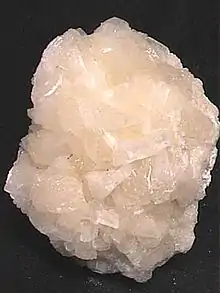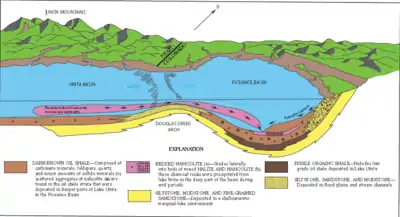| Nahcolite | |
|---|---|
 Nahcolite from California (size: 9.5 x 8 x 4 cm) | |
| General | |
| Category | Carbonate mineral |
| Formula (repeating unit) | Sodium bicarbonate (NaHCO3) |
| IMA symbol | Nah[1] |
| Strunz classification | 5.AA.15 |
| Dana classification | 13.01.01.01 |
| Crystal system | Monoclinic |
| Crystal class | Prismatic (2/m) (same H-M symbol) |
| Space group | P21/n |
| Unit cell | a = 7.47, b = 9.68 c = 3.48 [Å]; β = 93.38°; Z = 4 |
| Identification | |
| Colour | White to colourless, may be grey to brown |
| Crystal habit | Elongated crystals, fibrous masses, friable porous aggregates |
| Twinning | Common on [101] |
| Cleavage | {101} perfect, {111} good, {100} distinct |
| Fracture | Conchoidal |
| Tenacity | Brittle |
| Mohs scale hardness | 2.5 |
| Lustre | Vitreous - resinous |
| Streak | White |
| Diaphaneity | Transparent to translucent |
| Specific gravity | 2.21 |
| Optical properties | Biaxial (-) |
| Refractive index | nα = 1.377 nβ = 1.503 nγ = 1.583 |
| Birefringence | δ = 0.206 |
| Ultraviolet fluorescence | Short UV=blue-white cream-yellow, Long UV=cream-yellow |
| Solubility | Soluble in water |
| References | [2][3][4] |
Nahcolite is a soft, colourless or white carbonate mineral with the composition of sodium bicarbonate (NaHCO3) also called thermokalite. It crystallizes in the monoclinic system.[4]
Nahcolite was first described in 1928 for an occurrence in a lava tunnel at Mount Vesuvius, Italy.[2] Its name refers to the elements which compose it: Na, H, C, and O.[5] It occurs as a hot spring and saline lake precipitate or efflorescence; in differentiated alkalic massifs; in fluid inclusions as a daughter mineral phase and in evaporite deposits.[2][4]
It occurs in association with trona, thermonatrite, thenardite, halite, gaylussite, burkeite, northupite and borax.[3] It has been reported in a Roman conduit at Stufe de Nerone, Campi Flegrei, near Naples; in the U. S. from Searles Lake, San Bernardino County, California; in the Green River Formation, Colorado and Utah; in the Tincalayu deposit, Salar del Hombre Muerto, Salta Province, Argentina; on Mt. Alluaiv, Lovozero Massif and Khibiny Massif, Kola Peninsula, Russia; and around Mount Erebus, Victoria Land, Antarctica.[3]

References
- ↑ Warr, L.N. (2021). "IMA–CNMNC approved mineral symbols". Mineralogical Magazine. 85 (3): 291–320. Bibcode:2021MinM...85..291W. doi:10.1180/mgm.2021.43. S2CID 235729616.
- 1 2 3 Nahcolite on Mindat.org
- 1 2 3 Nahcolite in the Handbook of Mineralogy
- 1 2 3 Nahcolite data on Webmineral
- ↑ Richard V. Gaines, H. Catherine W. Skinner, Eugene E. Foord, Brian Mason, and Abraham Rosenzweig: Dana's new mineralogy, John Wiley & Sons, 1997